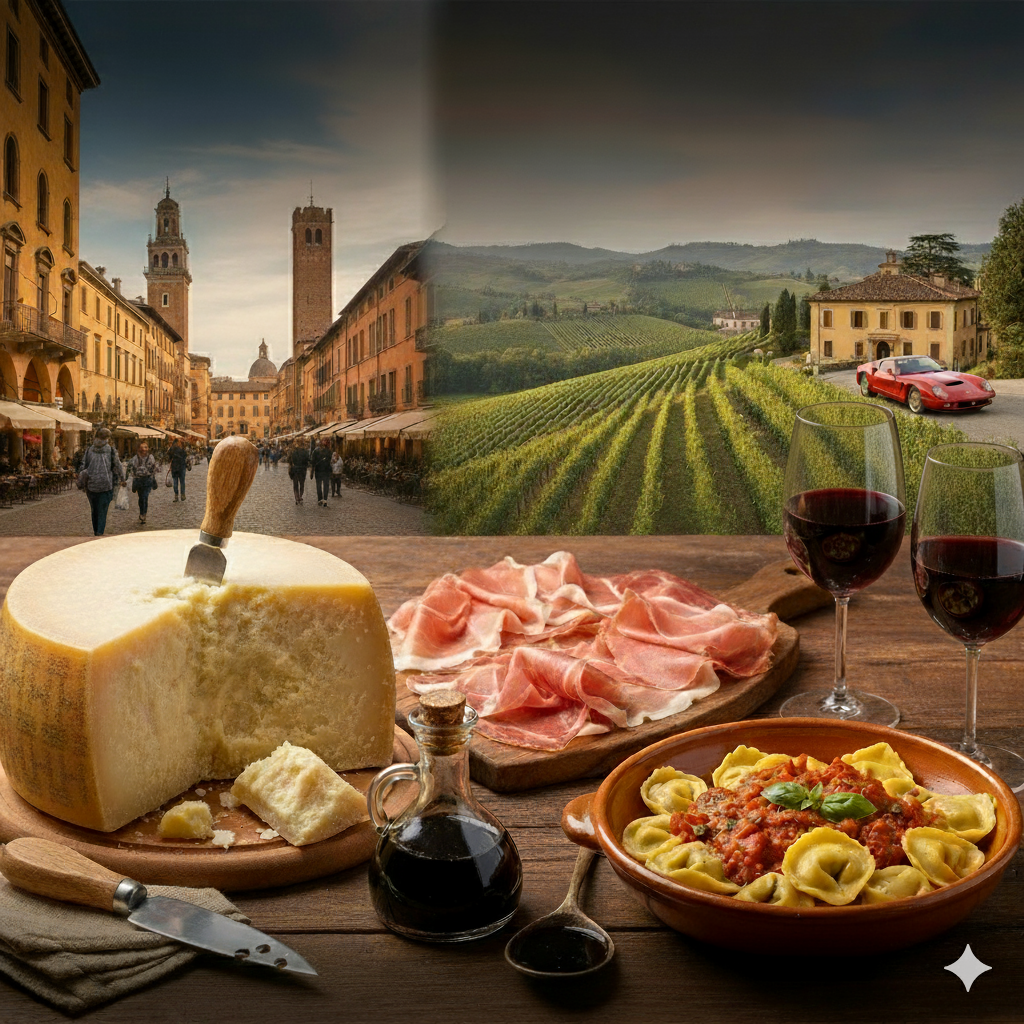And now, the feeling is back. That irresistible pull, the longing for the lyrical sound of the language, the taste of real pasta, the warmth of the Mediterranean sun. You’re ready to return. But the question looms: “What’s next?”
You’ve seen the “Big Three.” The idea of navigating those same colossal crowds or standing in those same epic lines feels less like a dream and more like a challenge. You crave something deeper. A taste of the “real Italy” you’ve heard whispers about—a place where life moves at a more human pace, where the food is not just a tourist attraction but the very soul of the culture, where history feels lived-in rather than just observed.
Allow us to introduce you to Emilia-Romagna. Tucked away in the fertile northern heartland of the country, this is the region savvy travelers know as Italy’s best-kept secret. It is, without exaggeration, the nation’s culinary epicenter, a treasure chest of Renaissance art, and the undisputed home of Italian high-performance engineering. It’s the Italy you’re looking for now. This guide will show you exactly why this incredible region should be at the very top of your list for your second, third, or even tenth trip to the bel paese.
Escaping the Crowds, Finding the Soul
There’s an undeniable thrill to seeing the world’s most famous landmarks. But a return trip to the same tourism epicenters can sometimes yield diminishing returns. The magic can be diluted by the sheer logistics of it all.
The Problem with the “Grand Tour” Redux
Revisiting the main tourist hubs often means contending with the realities of modern mass tourism. You find yourself in shoulder-to-shoulder crowds, paying premium prices for hotels and meals, and sometimes feeling like you’re on a well-worn conveyor belt, moving from one photo op to the next. It’s easy to feel like you’re inside a “tourist bubble,” slightly removed from the authentic daily life happening just a few streets away.
Emilia-Romagna offers the perfect antidote. Here, you’ll find magnificent UNESCO World Heritage sites, bustling medieval city centers, and world-class museums, but without the overwhelming density of visitors. It’s a region where tourism is welcomed and well-managed, but it doesn’t define the entire economy or the pace of life. This creates a more relaxed atmosphere, allowing for the kind of spontaneous discoveries and genuine interactions that make travel so rewarding. It’s the difference between observing Italy and truly experiencing it.
What is Emilia-Romagna? An Introduction to the Heartland
So, where exactly is this magical place? Located in Northern Italy, Emilia-Romagna stretches from the Apennine Mountains to the Adriatic Sea. Its backbone is the ancient Roman road, the Via Emilia, which connects its string of elegant, historic cities like pearls on a necklace. For centuries, this has been one of Europe’s most prosperous and culturally significant corridors.
The region is a place of delightful dualities. It’s home to Bologna, the oldest university in the Western world, earning it the nickname “La Dotta” (The Learned). It’s the cradle of refined art and music, especially in elegant Parma. Yet it’s also Italy’s “Motor Valley,” the high-octane birthplace of Ferrari, Lamborghini, Maserati, and Ducati. Its cities boast stunning Renaissance architecture, like in Ferrara, and priceless Byzantine mosaics in Ravenna. But above all, it’s known as Italy’s “Food Valley,” the undisputed agricultural and gastronomic capital of the nation. It’s a region that engages all the senses, offering a richer, more diverse experience than any single-focus destination.
A Culinary Universe Beyond Compare
Let’s be clear: you can find good food all over Italy. But there is nowhere else on earth—not even in Italy—that takes food as seriously, or produces it as masterfully, as Emilia-Romagna. This isn’t just a place with great restaurants; this is the source.
Why They Call It “The Food Valley”
Many of the products that define “Italian food” for the rest of the world originate here. This is the official, protected home of Parmigiano-Reggiano, Prosciutto di Parma, Mortadella di Bologna, and traditional balsamic vinegar. The fertile Po River Valley provides the perfect conditions for agriculture, and the people of the region have spent centuries perfecting the craft of transforming this bounty into culinary art.
This dedication to quality is enshrined in the strict DOP (Protected Designation of Origin) and IGP (Protected Geographical Indication) certifications. These labels are a legal guarantee that the product you’re enjoying is authentic, made according to time-honored traditions in its specific place of origin. Emilia-Romagna has more DOP and IGP products than any other region in Italy, making it a living museum of gastronomic excellence. A trip here is a journey to the heart of flavor itself.
The Holy Trinity of Flavor: Parma, Modena, and Bologna
While the entire region is a foodie paradise, its three central cities form a “holy trinity” of taste, each with its own unique and unmissable specialties.
Bologna: “La Grassa”
The regional capital, Bologna, is affectionately known as “La Grassa” (The Fat One), a name it wears with pride. This is the city of fresh egg pasta, where local artisans transform flour and eggs into silken sheets of tagliatelle, tiny, jewel-like tortellini, and rich green lasagna. The world-famous “Spaghetti Bolognese” is a foreign invention; the real deal is Tagliatelle al Ragù, a slow-simmered meat sauce served over wide, fresh noodles that perfectly capture its richness. Don’t leave without visiting the Quadrilatero, the city’s ancient market district just off the main Piazza Maggiore. Its narrow lanes are crammed with historic delis, bakeries, and market stalls overflowing with Mortadella (the original baloney, but infinitely more delicious), cheeses, and fresh produce. It’s a feast for the eyes and the stomach.
Parma
Just an hour away, the elegant city of Parma offers a more refined, almost aristocratic atmosphere. Its name is synonymous with two of Italy’s most prized culinary exports. The first is Parmigiano-Reggiano, the undisputed “King of Cheeses.” Visiting a local caseificio (cheese dairy) is a must-do experience. Watching the cheesemakers work their magic, transforming fresh milk into massive wheels of nutty, crystalline cheese, and then stepping into the cathedral-like aging rooms where thousands of wheels rest in silent perfection, is to witness edible alchemy. The second king is Prosciutto di Parma, the sweet, delicate, and perfectly cured ham. A tour of a prosciutto producer reveals the simple genius of the process: just pork, sea salt, air, and time.
Modena: The Epicenter of Taste
Nestled between Parma and Bologna lies Modena. Though quieter than its neighbors, Modena is a place of deep, almost spiritual gastronomic tradition. It’s famous for its role in the Motor Valley, but its true soul lies in its food. It’s the home of hearty dishes like zampone and cotechino, and the birthplace of the modern Lambrusco wine renaissance. But its most sacred contribution to the world’s pantry is balsamic vinegar.
A trip to Modena is a chance to discover the real thing, a moment that will fundamentally change your understanding of flavor. The experience of visiting a traditional acetaia, or balsamic vinegar cellar, is unforgettable. These cellars house batteries of wooden barrels, some of which have been in use for centuries. Here, you learn the secret: it’s not wine vinegar. It starts with the cooked must of local grapes, which is then aged for a minimum of 12, and often more than 25, years. Each year, it is lovingly transferred from one barrel to the next, each made of a different wood (oak, cherry, juniper, ash), gaining color, density, and an incredible complexity of flavor. This is a taste of history itself, a tradition passed down through generations. To experience the profound complexity of the original balsamic vinegar of Modena is to understand the soul of this region, a flavor that is impossible to replicate and unforgettable once tasted.
Don’t Forget the Wine: Lambrusco’s Renaissance
For years, Americans associated Lambrusco with the cheap, fizzy, and cloyingly sweet red wine that was popular in the 1970s. A trip to Emilia-Romagna will shatter that misconception. The region is in the midst of a Lambrusco renaissance, with artisanal producers crafting dry, complex, and beautifully nuanced sparkling red and rosé wines. These are the real Lambruscos, the kind locals drink, and they are the perfect pairing for the region’s rich cuisine, with their bright acidity cutting through the fat of cured meats and cheeses.
More Than Just Food: Culture, Cars, and Coastlines
While you could easily spend your entire trip eating, Emilia-Romagna offers a wealth of other attractions that make it a truly well-rounded destination.
A Feast for the Eyes: Art, History, and Architecture
This region was a major center of civilization long before Italy was a unified country. Head east toward the Adriatic coast to Ravenna, the final capital of the Western Roman Empire. Here you’ll find eight UNESCO World Heritage sites, home to the most stunning collection of early Christian Byzantine mosaics in the world. The glittering gold and jewel-toned tiles that adorn its churches and mausoleums will leave you speechless.
Nearby, the city of Ferrara is a perfectly preserved Renaissance gem, encircled by miles of intact city walls that you can walk or bike. Its imposing Este Castle, complete with a moat, dominates the city center. And in Bologna, you can climb the Asinelli Tower for a panoramic view of the city’s red rooftops or simply wander for hours under its 25 miles of beautiful covered porticoes, also a UNESCO site.
The Need for Speed: Italy’s Motor Valley
For a thrilling change of pace, dive into the high-octane world of Italy’s Motor Valley. The area between Modena and Bologna is the hallowed ground for some of the world’s most iconic automotive and motorcycle brands. You can visit the stunning Enzo Ferrari Museum in Modena, the Lamborghini factory and museum in Sant’Agata Bolognese, and the Ducati museum in Bologna. For anyone with even a passing interest in design, engineering, or speed, this is a unique and exhilarating aspect of the region you simply won’t find anywhere else.
Planning Your Emilia-Romagna Adventure
Convinced? Planning a trip to Emilia-Romagna is refreshingly straightforward.
Practical Tips for the Savvy Traveler
- How to Get There: The easiest way is to fly into Bologna’s Guglielmo Marconi Airport (BLQ), which has connections from all major European hubs.
- Best Time to Visit: Spring (April-June) and Fall (September-October) offer pleasant weather, perfect for exploring the cities, and coincide with fantastic food festivals and harvests.
- Getting Around: The region is incredibly easy to navigate by train. The main cities on the Via Emilia (Parma, Reggio Emilia, Modena, Bologna) are all connected by frequent, fast, and affordable rail service. Renting a car is only necessary if you want to explore the deep countryside.
- Sample Itinerary: A week is a great starting point. Consider 3 days in Bologna as your base, using it to explore the city and take a day trip to Ravenna. Then, spend 2 days in Modena, using it as a base to visit a balsamic vinegar producer and the Ferrari museum. Finish with 2 days in Parma to explore the city and visit a Parmigiano-Reggiano dairy.
While your first trip to Italy may have been about seeing the magnificent overture—the iconic monuments that form our collective idea of the country—a trip to Emilia-Romagna is about experiencing the main act. It’s a journey into the rich, complex, and deeply satisfying heart of Italian culture. It’s where you go to escape the crowds and find the flavor, to trade checklists for genuine discoveries. So, when you’re ready to go beyond the familiar, to taste a more authentic side of Italy, book your ticket to Bologna. A delicious, unforgettable adventure awaits.

